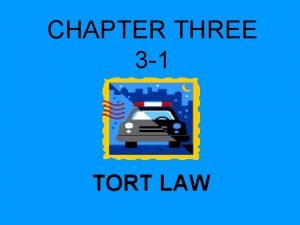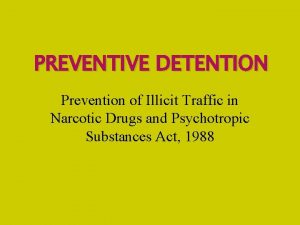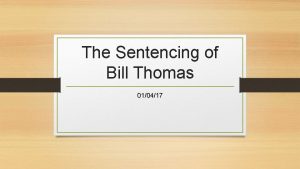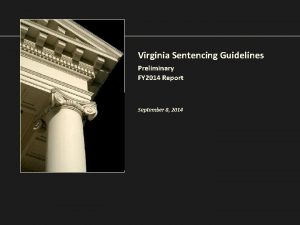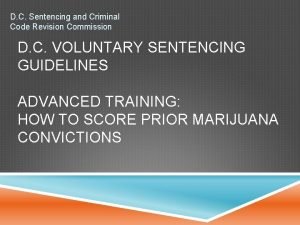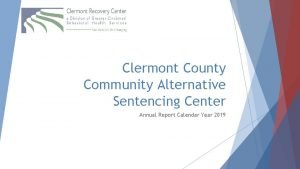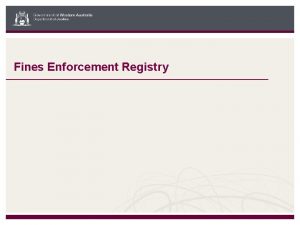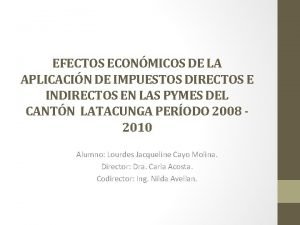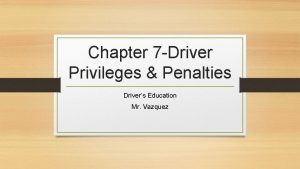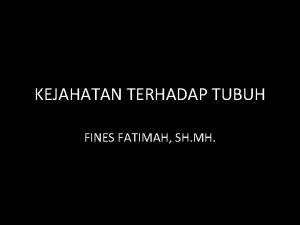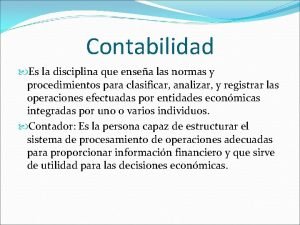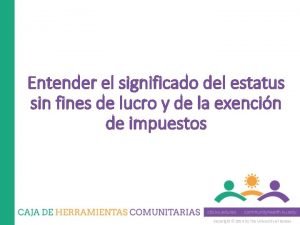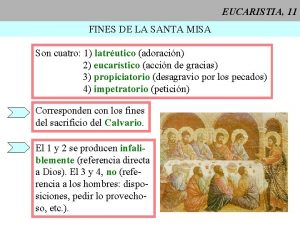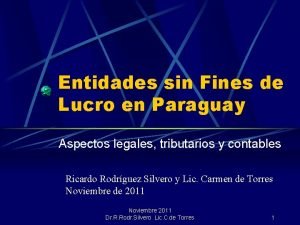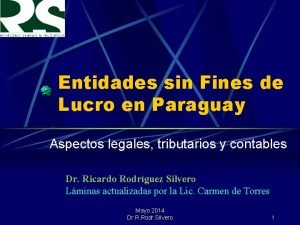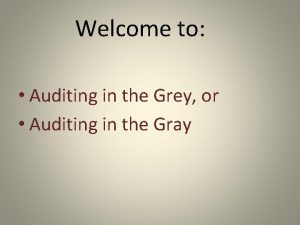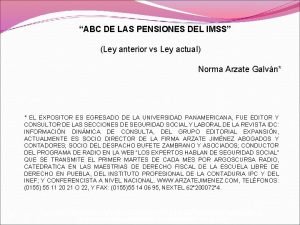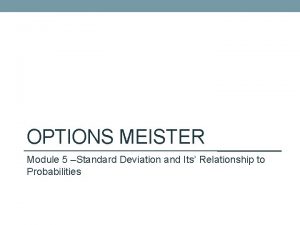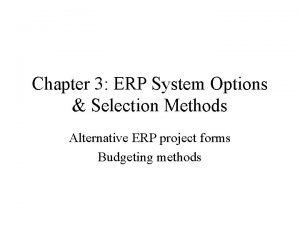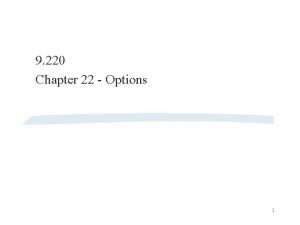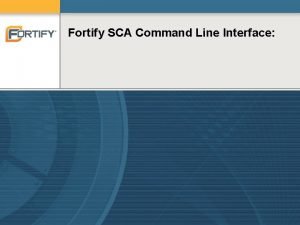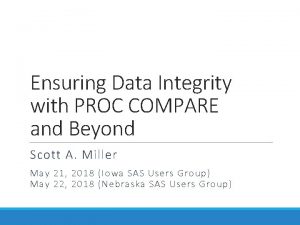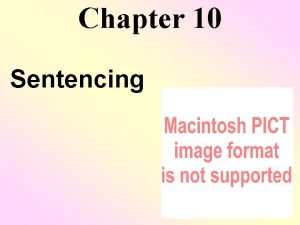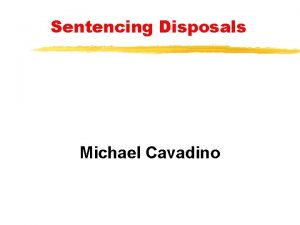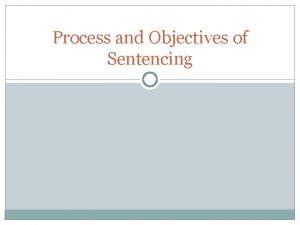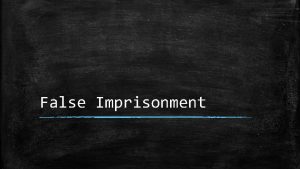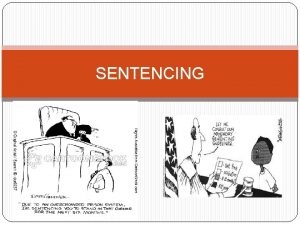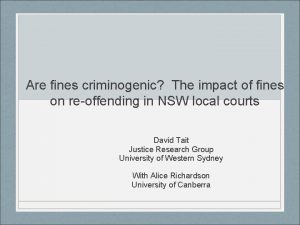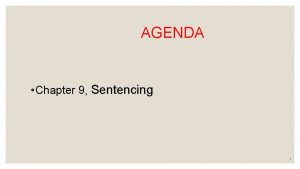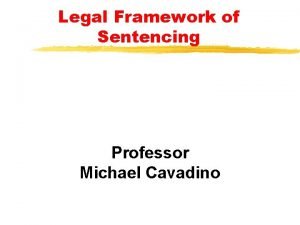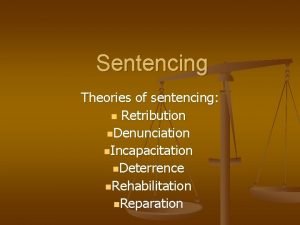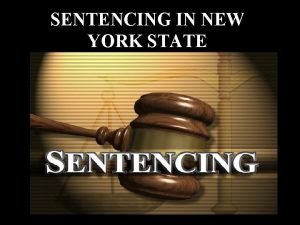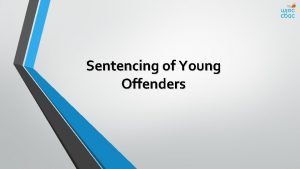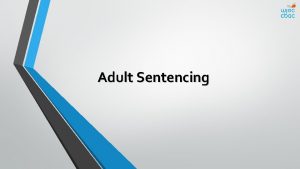Chapter 10 Sentencing Traditional Sentencing Options imprisonment fines































































- Slides: 63

Chapter 10 Sentencing

Traditional Sentencing Options • imprisonment • fines • probation • death © 2003 Prentice Hall, Inc. 2

Sentencing Goals of Sentencing © 2003 Prentice Hall, Inc. • retribution • incapacitation • deterrence • rehabilitation • restoration 3

Retribution • The act of taking revenge on a perpetrator. • Early punishments were swift and immediate. • Death and exile were common punishments. • Retribution follows the Old Testament’s “an eye for an eye. ” • Retribution holds offender personally responsible. © 2003 Prentice Hall, Inc. 4

Incapacitation • Incapacitation is the use of imprisonment, or other means, to reduce the likelihood that an offender will be capable of committing future offenses. • In ancient times, mutilation and amputation were used to incapacitate. • Incapacitation requires restraint, not punishment. • It is on the increase in the United States, as evidenced by the building of additional prison facilities nationwide. © 2003 Prentice Hall, Inc. 5

Deterrence • A goal of criminal sentencing that seeks to inhibit criminal behavior through fear of punishment. • It demonstrates to public that crime is not worthwhile. • There are two types of deterrence: • specific • general © 2003 Prentice Hall, Inc. 6

Deterrence • hedonistic calculus - Jeremy Bentham’s belief that people weigh the perceived rewards of criminal behavior against the perceived punishments. • Bentham believed that crime will be prevented when perceived punishment outweighs perceived reward. © 2003 Prentice Hall, Inc. 7

Specific Deterrence • Specific deterrence is a goal of criminal sentencing which seeks to prevent a particular offender from engaging in repeat criminality. • incapacitation - At least during time offender is incapacitated he/she is not committing another crime against free society. • death sentence - An individual is incapable of committing another crime once sentence is carried out. © 2003 Prentice Hall, Inc. 8

General Deterrence • General deterrence is a goal of criminal sentencing that seeks to prevent others from committing crimes similar to the one for which a particular offender is being sentenced by making an example of the person sentenced. • Examples of general deterrence would include public floggings and hangings. © 2003 Prentice Hall, Inc. 9

Rehabilitation • The attempt to reform a criminal offender. Also, the state in which a reformed offender is said to be. • By reforming the offender, it is believed the number of crimes occurring will be reduced. • Education, training, and counseling are some of the vehicles used. • The concept was developed in the 1930’s as a result of the growth of psychology. © 2003 Prentice Hall, Inc. 10

Restoration • Restoration is the goal of criminal sentencing that attempts to make the victim “whole again. ” • Crime is a violation of a person as well as the State. • Restorative justice addresses the needs of the person (victim). • The following are types of restoration: • counseling • money for: medical bills, lost wages, suffering © 2003 Prentice Hall, Inc. 11

Sentencing Two Types: • indeterminate • determinate (fixed) © 2003 Prentice Hall, Inc. 12

Indeterminate Sentencing A model of criminal punishment which encourages rehabilitation via the use of general and relatively unspecific sentences, such as a term of imprisonment “from one to ten years. ” © 2003 Prentice Hall, Inc. 13

Indeterminate Sentencing • Indeterminate sentencing allows the judge to have a wide range of discretion. • Sentences are often given in a range, i. e. , “one to ten years. ” • Probation and parole are options. • Degrees of guilt can be taken into account. © 2003 Prentice Hall, Inc. 14

Indeterminate Sentencing “Good Time” • Offender can receive credit for good behavior and thereby reduce the amount of time s/he spends incarcerated. • The behavior of the offender during incarceration is the main determining factor of when an individual is released under indeterminate sentencing. © 2003 Prentice Hall, Inc. 15

Bureau of Justice Statistics 1999 study: • Violent offenders serve only 51% of their sentences prior to release. • 49%of the sentence is served prior to release for all felonies. • Many of the early releases have been necessitated by prison overcrowding. © 2003 Prentice Hall, Inc. 16

Rise of Structured Sentencing A model of criminal punishment that includes determinate and commission-created presumptive sentencing schemes, as well as voluntary/ advisory sentencing guidelines. © 2003 Prentice Hall, Inc. 17

Rise Sentencing Riseof of. Structured Sentencing Developed, in part, as a response to the disparity in sentencing of the indeterminate model. © 2003 Prentice Hall, Inc. 18

Rise Sentencing Riseof of. Structured Sentencing • proportionality • equity • social debt © 2003 Prentice Hall, Inc. 19

Structured Sentencing Proportionality The severity of the sanction should be directly related to the seriousness of the crime committed.

Structured Sentencing Equity Similar crimes should receive similar sentences, regardless of the characteristics of the offender. © 2003 Prentice Hall, Inc. 21

Structured Sentencing Social Debt The offender’s criminal history should be taken into account during sentencing, i. e. , the more crimes previously committed, the harsher the sentence. © 2003 Prentice Hall, Inc. 22

Determinate Sentencing A model of criminal punishment in which an offender is given a fixed term that may be reduced by good time or earned time. Under the model, for example, all offenders convicted of the same degree of burglary would be sentenced to the same length of time behind bars. © 2003 Prentice Hall, Inc. 23

Structured Sentencing • Offender is given a fixed sentence length. • The sentence can be reduced by “good time. ” • The use of parole is eliminated. © 2003 Prentice Hall, Inc. 24

Presumptive Sentencing Model of punishment that meets the following conditions: 1. Proper sentence is presumed to fall within the range authorized by sentencing guidelines. 2. If judges deviate from guidelines, they must provide written justification. 3. Sentencing guidelines provide for some review, usually by an appellate court. © 2003 Prentice Hall, Inc. 25

Sentencing Guidelines First states to approve use of sentencing guidelines: • • Minnesota (1980) Pennsylvania (1982) Washington (1983) Florida (1983) The federal government and 16 states now follow sentencing guidelines. © 2003 Prentice Hall, Inc. 26

Sentencing Guidelines Most state sentencing guidelines allow for mitigating factors and/or aggravating factors. © 2003 Prentice Hall, Inc. 27

28 • • helped in apprehension of another felon good community reputation already made partial/full restitution no prior record guidelines: lower a sentence from that specified in Examples of factors that cause a judge to Mitigating Factors © 2003 Prentice Hall, Inc.

Sentencing Guidelines • Victim was a voluntary participant or acted under provocation. • Offense was committed under duress, coercion, or threat which was not sufficient for defense but reduces culpability. © 2003 Prentice Hall, Inc. 29

Aggravating Circumstances Those factors related to the crime or defendant that would cause a judge to increase the sentence from those established by the guidelines. Examples: • Defendant induced others to participate. • Offense was especially heinous. • Defendant was armed. © 2003 Prentice Hall, Inc. 30

Aggravating Circumstances • Offense was committed for hire. • Victim was a law enforcement officer. • Defendant took advantage of position of trust. © 2003 Prentice Hall, Inc. 31

Mandatory Sentencing Structured sentencing which allows NO leeway in the nature of the sentence established for the crime. Example: • three-strikes law • requires mandatory sentence when convicted of third felony • imposes much longer prison terms © 2003 Prentice Hall, Inc. 32

Structured Sentencing truth in sentencing - A close correspondence between the sentence imposed upon an offender and the actual time served prior to release from prison. © 2003 Prentice Hall, Inc. 33

Structured Sentencing Violent Crime Control and Law Enforcement Act of 1994 provided money to entice states to pass “truth in sentencing” laws…. money to be used for prison construction in those states that complied © 2003 Prentice Hall, Inc. 34

Federal Sentencing Guidelines U. S. Sentencing Commission • • • established under Sentencing Reform Act of 1984 9 member commission establishes minimum sentences for certain federal crimes limited federal judges discretion guidelines in effect - November 1987 challenged on legal grounds Mistretta v. U. S. © 2003 Prentice Hall, Inc. 35

Mistretta v. U. S. (1989) U. S. Supreme Court held that Congress had acted appropriately in establishing the Sentencing Commission and the guidelines could be applied to federal cases nationwide. © 2003 Prentice Hall, Inc. 36

Career Offender Federal label requiring defendant to meet 3 criteria: • Defendant is at least 18 at time of offense. • Offense is a crime of violence or trafficking in a controlled substance. • Defendant has at least two prior felony convictions for crimes of violence or trafficking. © 2003 Prentice Hall, Inc. 37

Career Offender Deal v. U. S. (1993) • Deal was convicted of 6 counts of carrying and using a firearm in a series of bank robberies • Deal was sentenced to 105 years in prison as a career offender. • The sentences were to run consecutively. © 2003 Prentice Hall, Inc. 38

Career Offender Court rejected appeal stating, “We see no reason why the defendant should not receive such a sentence, simply because he managed to evade detection, prosecution, and conviction for the first five offenses and was ultimately tried on all six in a single proceeding. ” © 2003 Prentice Hall, Inc. 39

Plea Bargaining Federal Level Of all federal cases, 90% are the result of guilty pleas, of which the vast majority are the result of plea negotiations. © 2003 Prentice Hall, Inc. 40

Innovations in Sentencing • Shaming is used as a crime reduction strategy. • California courts are making racially equitable sentencing decisions. © 2003 Prentice Hall, Inc. 41

Presentence Investigation Report • long form Three types • detailed written report on the defendant’s personal and criminal history • short form • summarizes type of information most likely to be useful in sentencing decision • verbal report • made by the investigating officer based on field notes © 2003 Prentice Hall, Inc. 42

Presentence Investigation Report Ten Major Informational Sections • personal information and identifying data • chronology of the current offense and circumstances surrounding it • record of previous convictions • home life and family data • educational background • • • health history military service religious preference financial condition sentencing recommendation © 2003 Prentice Hall, Inc. 43

Presentence Investigation Report Federal law mandates a presentence report in federal court. © 2003 Prentice Hall, Inc. 44

The Sentencing of Convicted Felons in State Courts by Type of Offense Matthew R. Durose, David J. Levin, and Patrick A. Lanagan, Felony Sentences in State Courts, 1998 (Washington, D. C. : Bureau of Justice Statistics, 2001) © 2003 Prentice Hall, Inc. 45

Court-ordered Prison Commitments, 1960 -1998 © 2003 Prentice Hall, Inc. 46

The Victim • consideration of victims and their survivors • victims’ rights movement • victims’ assistance programs © 2003 Prentice Hall, Inc. 47

The Victim Restorative justice Emphasizes offender accountability and victim reparation. © 2003 Prentice Hall, Inc. 48

The Victim victim-impact statements Description of losses, suffering, and trauma experienced by the victims or their survivors. © 2003 Prentice Hall, Inc. 49

Sentencing Options Imprisonment Bureau of Justice Statistics reports: • 927, 717 people convicted in 1998 in state felony courts. • 44% of those convicted received active prison terms. • 24% received jail sentences of less than one year. © 2003 Prentice Hall, Inc. 50

Sentencing Options Imprisonment • 32% of those convicted are sentenced to probation. • The average prison sentence is 5 years. • The average prison sentence served is 2 years. © 2003 Prentice Hall, Inc. 51

Sentencing Options Fines are one of the oldest forms of punishments (predates the Code of Hammurabi). © 2003 Prentice Hall, Inc. Advantages: • Fines contribute to state treasury. • Criminals are deprived of the proceeds of criminal activity. • Fines are inexpensive to collect. • Fines can be made proportionate to severity of offense. 52

Sentencing Options Fines Criticisms: • Offender often serves no time. • Fines are a “mild” form of punishment. • Fines discriminate against the poor. • Fines are difficult to collect. © 2003 Prentice Hall, Inc. 53

Sentencing Options Isr ins ael tit – b ut ib ed lic pu al t bli im c s es to nin g Death: ng i ad urn e b h be sed ed u s u lso – s n, a n a fte ts m o is Ro ost on m r ars fo l s - rdea e Ag y o k r sb a n D tio u ec ex History Gr us eek ed S po oci iso ety n t (2 o l 00 im B. it s C. E uff. ) eri ng © 2003 Prentice Hall, Inc. 54

Sentencing Options • Up until the 1890’s, hanging was the predominant form of execution. • Currently, the majority of states use lethal injection. © 2003 Prentice Hall, Inc. 55

U. S. Executions by State 1976 -2000 Source: Death Penalty Information Center, data as of January 2, 1999 © 2003 Prentice Hall, Inc. 56

Writ of Habeas Corpus • It is an order directing the person detaining a prisoner to bring him or her before a judicial officer to determine the lawfulness of the imprisonment. • It is Latin, meaning “you have the body. ” © 2003 Prentice Hall, Inc. 57

Opposition to Death Penalty • could be used on innocent people • not an effective deterrent • imposition both arbitrary and discriminatory • far too expensive to justify • reduces us to level of the criminal © 2003 Prentice Hall, Inc. 58

Support for Death Penalty • revenge - Only after execution can survivors begin to heal psychologically. • just deserts - Some people deserve to die for what they did. • protection - Once executed, the person cannot commit another crime. © 2003 Prentice Hall, Inc. 59

Death Penalty & Court Cases In re Kemmler U. S. Supreme Court defined cruel and unusual methods of execution as follows: “Punishments are cruel when they involve torture or lingering death; but the punishment of death is not cruel, within the meaning of that word as used in the Constitution. ” © 2003 Prentice Hall, Inc. 60

Death Penalty & Court Cases Furman v. Georgia (1972) “evolving standard of decency” © 2003 Prentice Hall, Inc. The Court invalidated Georgia’s death penalty statute on the basis that it allowed a jury unguided discretion in the imposition of a capital sentence. 61

Death Penalty & Court Cases Gregg v. Georgia (1976) © 2003 Prentice Hall, Inc. The Court upheld the twostep procedure requirements of Georgia’s new capital punishment law as necessary for ensuring the separation of the highly personal information needed in a sentencing decision from the kinds of information reasonably permissible in a jury trial. 62

Future of the Death Penalty • There is little common ground for pros and cons of the death penalty. • The future of the death penalty rests with state legislatures. © 2003 Prentice Hall, Inc. 63
 False imprisonment in healthcare
False imprisonment in healthcare Example of false imprisonment
Example of false imprisonment Unit 4 criminology
Unit 4 criminology What is preventive imprisonment
What is preventive imprisonment The sentencing of bill thomas
The sentencing of bill thomas Virginia probation violation sentencing guidelines
Virginia probation violation sentencing guidelines Indeterminate sentencing juvenile
Indeterminate sentencing juvenile Dc sentencing commission
Dc sentencing commission Casc clermont
Casc clermont Adónde vas los fines de semana
Adónde vas los fines de semana Plan de marketing de coca cola
Plan de marketing de coca cola Estado de resultados contabilidad
Estado de resultados contabilidad Fines enforcement registry
Fines enforcement registry Fines mixtos
Fines mixtos Fines educativos ejemplos
Fines educativos ejemplos Fines will be imposed to a motorist:
Fines will be imposed to a motorist: Fines fatimah
Fines fatimah Cuales son los fines fundamentales de la contabilidad
Cuales son los fines fundamentales de la contabilidad Que haces normalmente los fines de semana
Que haces normalmente los fines de semana Sin fines de lucro significado
Sin fines de lucro significado Ifta audit fines
Ifta audit fines Solicitud de informe no coincidencia o similitud de nombre
Solicitud de informe no coincidencia o similitud de nombre Dewetting solder
Dewetting solder Estructura de la eucaristia
Estructura de la eucaristia Empresas sin fines de lucro en paraguay
Empresas sin fines de lucro en paraguay Asociaciones sin fines de lucro paraguay
Asociaciones sin fines de lucro paraguay Ofni y finees hijos de eli
Ofni y finees hijos de eli Ifta audit fines
Ifta audit fines Fines de la educacion en honduras
Fines de la educacion en honduras Crédito fines generales coopeuch
Crédito fines generales coopeuch Declaracion anual personas morales con fines no lucrativos
Declaracion anual personas morales con fines no lucrativos Chapter 3 food service career options worksheet answers
Chapter 3 food service career options worksheet answers What sort of evidence was used to arrest accused witches
What sort of evidence was used to arrest accused witches Systems analysis & design in an age of options pdf
Systems analysis & design in an age of options pdf Language
Language Option stock
Option stock Standard deviation options
Standard deviation options Kim klaiman
Kim klaiman Options for formulating a digital transformation strategy.
Options for formulating a digital transformation strategy. Option appraisal methods
Option appraisal methods Global operation strategy option
Global operation strategy option Molina medicare washington
Molina medicare washington Wan connectivity options
Wan connectivity options Creative hunt thinking routine
Creative hunt thinking routine Macro instruction
Macro instruction Explain machine independent loader features in detail
Explain machine independent loader features in detail Wan osi layer
Wan osi layer Engagement options
Engagement options Euro btp futures
Euro btp futures Tiziana ferrari
Tiziana ferrari Options fashion distribution
Options fashion distribution Circle the correct options
Circle the correct options Erp system options and selection methods
Erp system options and selection methods Benefitoptions.az.gov
Benefitoptions.az.gov Put options
Put options Gdn targeting options
Gdn targeting options Option hacker keene
Option hacker keene Postsecondary education options
Postsecondary education options Ipers retirement options
Ipers retirement options Wewelogin
Wewelogin Options-based planning
Options-based planning What is fortify scan
What is fortify scan Sas proc compare maxprint
Sas proc compare maxprint Gap call option
Gap call option

